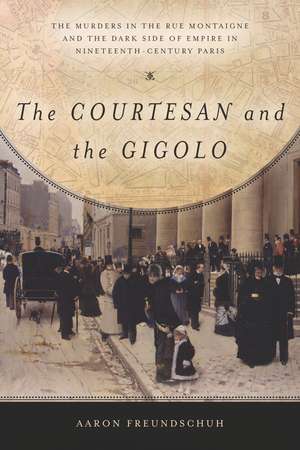The Courtesan and the Gigolo: The Murders in the Rue Montaigne and the Dark Side of Empire in Nineteenth-Century Paris
Autor Aaron Freundschuhen Limba Engleză Paperback – 10 ian 2017
Aaron Freundschuh's account of the "Pranzini Affair" recreates not just the intricacies of the investigation and the raucous courtroom trial, but also the jockeying for status among rival players—reporters, police detectives, doctors, and magistrates—who all stood to gain professional advantage and prestige. Freundschuh deftly weaves together the sensational details of the case with the social and political undercurrents of the time, arguing that the racially charged portrayal of Pranzini reflects a mounting anxiety about the colonial "Other" within France's own borders. Pranzini's case provides a window into a transformational decade for the history of immigration, nationalism, and empire in France.
| Toate formatele și edițiile | Preț | Express |
|---|---|---|
| Paperback (1) | 211.68 lei 6-8 săpt. | |
| Stanford University Press – 10 ian 2017 | 211.68 lei 6-8 săpt. | |
| Hardback (1) | 503.25 lei 6-8 săpt. | |
| Stanford University Press – 10 ian 2017 | 503.25 lei 6-8 săpt. |
Preț: 211.68 lei
Nou
40.51€ • 42.24$ • 33.67£
Carte tipărită la comandă
Livrare economică 20 martie-03 aprilie
Specificații
ISBN-10: 1503600823
Pagini: 272
Dimensiuni: 152 x 229 x 18 mm
Greutate: 0.36 kg
Editura: Stanford University Press
Colecția Stanford University Press
Recenzii
Notă biografică
Cuprins
This chapter traces the historical geography of western and west-central Paris in the eighteenth and nineteenth centuries, with particular attention to the neighborhood near the lower Champs-Elysées and the Rue Montaigne, site of the horrific triple homicide that is the book's main focus. The chapter introduces themes pertaining to spatial divisions of modern Paris, highlighting the process of gentrification and the embedding of cosmopolitan and bourgeois social elements in the area. The Paris of Napoleon III and Baron Haussmann reinforced the very fantasies of social-spatial purity that the Pranzini arrest would upend.
This chapter tightens the narrative focus around the March 1887 date of the murders and visits the crime scene. The chapter introduces important early investigative findings, as well as the central investigators in the case: the crime reporter Georges Grison, Chief of Security Taylor, Deputy-Chief Goron, the magistrate Adolphe Guillot, and Dr. Paul Brouardel, the renowned forensics doctor and anatomist. The investigative rivalries among these men constitute a narrative arc running through the book. The Pranzini case was considered vital to attempts on the part of the police to fix its tattered reputation as it attempted to "professionalize" in the 1880s and 1890s.
This chapter constitutes the first historical treatment of an important figure in the rise of investigative reporting in Paris: Georges Grison. For decades a fixture at Parisian crime scenes, Grison toiled as a lowly crime reporter of the fait-divers newspaper genre. The argument is that Grison¿a deft professional networker, scandal-monger and controversial press advocate who published under the pen name Jean de Paris¿pioneered new journalistic techniques as part of an ethos of investigation that appealed to readers of the mass press. Working under the protection of press freedoms guaranteed by the Third Republic and seeing in this case a unique opportunity, Grison used this case to challenge the limits of printable news and the role of the press in investigating crime.
This chapter retraces the public fascination with, and the police investigation of, Marie Regnault's early life, as well as her rise in the demimonde. How was the life of a courtesan measured by Regnault's contemporaries? Did her murder constitute a mournful public tragedy? Regnault's murder is situated alongside other unsolved cases involving demimondaines going back to 1879. A novel angle on the strategies of the demimonde is in evidence in the so-called "secret archives" of the Vice Squad¿a powerful investigative division overseen by Taylor and Goron¿as well as in the material history of sex work that unfolded in Paris's most prestigious auction house, the Hôtel Drouot, where Regnault's own belongings were sold one year after her murder.
This chapter pieces together the Rue Montaigne investigation's eastward movements through diplomatic, military, and political sources. The French diplomatic corps's pursuit of Pranzini's past¿ostensibly undertaken to determine his prior criminal activity and his whereabouts going back to 1879¿produced a wealth of data relative to Pranzini's family history, which is here contextualized within the broader historical trend of European colonial migration and settlement in the East during the nineteenth century. In Alexandria, a magnet for southern European colonial settlers, social hierarchies and racial tensions helped transform the exonym "Levantine" into a pejorative¿a category that Pranzini, a product of the French empire in important respects, was coming simultaneously to embody in Paris.
This chapter proceeds along two parallel tracks while carrying the case narrative forward to the interrogation phase. In order to understand how the Pranzini case impacted the investigative imagination in Paris, the chapter picks up Chapter One's discussion of the stakes of the investigation for Security, arguing that this case was an important moment in the agency's history. This was because Deputy Chief, a veteran of colonial settlement and war, saw in the investigation's colonial dimension an opportunity to valorize the colonial experience and culture that were a source of pride within Security's ranks. Pranzini, meanwhile, was held up as an example of a "rastaquouère," a racialized colonial category that evoked European settlement in South America, unwanted social backwash, and forms of criminality such as sex trafficking.
The Pranzini was an extraordinarily rowdy event, replete with outbursts of laughter that are the subject of this chapter's inquiry. Linking the trial to the rise of General Georges Boulanger and the early coalescence of right-wing factions into a movement known to historians as the "New Right," the chapter argues that Pranzini¿as a foreigner coded as an infiltrator and sexual threat¿became a convenient target for modern French political xenophobia. As a gigolo, Pranzini was typed as risible, effeminate, and recognizable on the butte of Montmartre; at the same time, he infused that social type with hints of the exotic that could appeal to independent-minded Parisian women.
Chapter Eight recounts the grotesque aftermath of Pranzini's guilty verdict. Georges Grison's revelation that Taylor, Goron, and one of their underlings were each in possession of souvenirs fashioned from the post-cranial cadaver of Enrico Pranzini set off a chain of events that led to the stunning fall of Jules Grévy. More than a sensational anecdote, the so-called "Skin Affair" nourished debates about the procedures surrounding the death penalty, the punishment of the colonial body, and the right of death-row convicts to exempt their cadavers from posthumous medical research.
The Conclusion revisits the notion that for Parisians in the 1880s, the political themes of criminality and colonial empire were intimately tied. The Pranzini case took social theorists like Gabriel Tarde aback. At the same time, other unwanted reverberations from overseas dealt fatal blows to the careers of pro-colonial politicians like Ferry. Empire's promise of security and stability was left most wanting as it pertained to discourses on crime. In the months following the Pranzini Affair, Enrico Pranzini's name officially entered the French parliamentary record. Xenophobic politicians cited his example in their re-framing of immigration as an imperial question; they cited his example, and the press coverage of the case, as justifications for a stricter regime of immigrant control¿one that would endure for generations.














